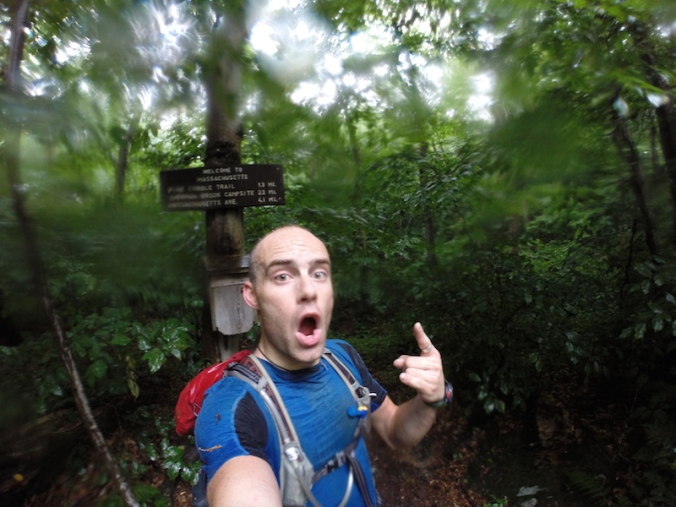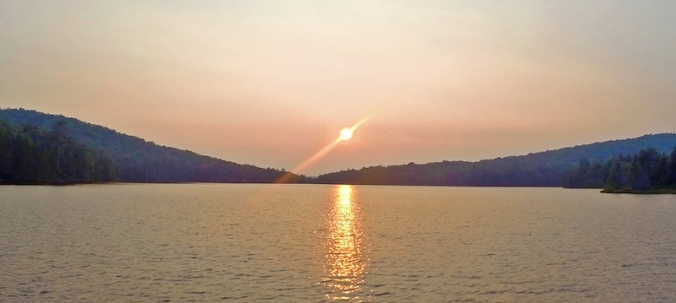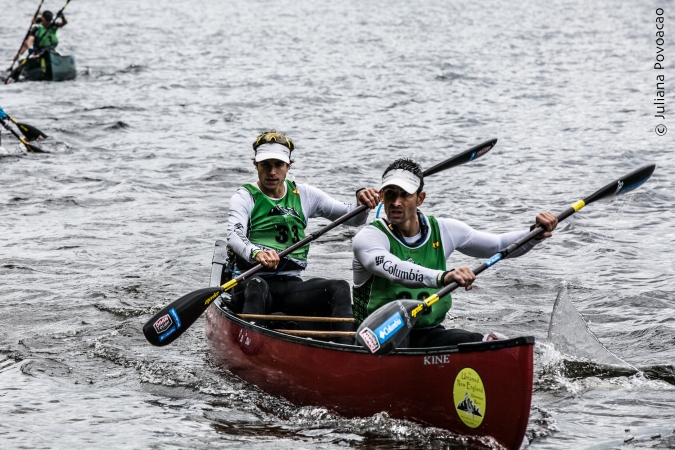By: Kel Rossiter

Autumn’s confetti of color served as a festive audience along our journey.
Wilderness has always been a contested term. The word offers an expanse of subjectivity in which to insert interpretation and to project meaning. In 1964, wilderness was given an official political definition with the passage of the Wilderness Act. Congressional acts aren’t often noted for their eloquence, so The Wilderness Act of 1964 is all the more exceptional in its lyrical designation of wilderness as:
“A wilderness, in contrast with those areas where man and his own works dominate the landscape, is hereby recognized as an area where the earth and its community of life are untrammeled by man, where man himself is a visitor who does not remain.”
With that act, Congress settled itself upon a term for what wilderness was and set about designating certain areas of federal lands—national parks, forests, and otherwise—as “Wilderness Areas.”

Our route through the Sandwich and Pemigewasset Wilderness Areas in NH.
Flash forward 50 years and I found myself with my long-time outdoor partner and environmental historian friend Dave back in the early and cold months of 2014. During an approach to some Huntington Ravine ice climbing, we struck upon the realization that it was the 50th anniversary of the Wilderness Act, in yet, with all the silence of a tree falling in the forest with no one around to hear it, neither of us had heard about anything being done to commemorate the Wilderness Act. So, we began to consider ways in which we could contribute a personal celebration to the Wilderness Act party.
How precisely that led to us coming up with the “50 Miles of Wilderness for 50 Years of Wilderness” idea I still can’t piece together: While I did the Boston Marathon a decade ago, to call me a distance runner would be like calling Neil Armstrong an alien because he once walked on the moon. Dave, for his part, does trail run regularly, but to call him a die-hard distance runner would be like mistaking President Obama for the Pope because Barack happens to go to church regularly. It would have made much more sense to devise a “50 Wilderness Climbs for 50 Years of Wilderness” or, hell, even “50 Hours of Freezing Your Butt Off on some Weird Link-up of Climbs for 50 Years of Wilderness” but somehow we settled on “50 Miles of Wilderness for 50 Years of Wilderness” (it did have a nicer ring to it)…and that explains how I found myself stumbling around in the fog in the dark-AM hours of October 1st, looking for the trail that would lead us to the top of Mount Whiteface, our first highpoint on the journey.
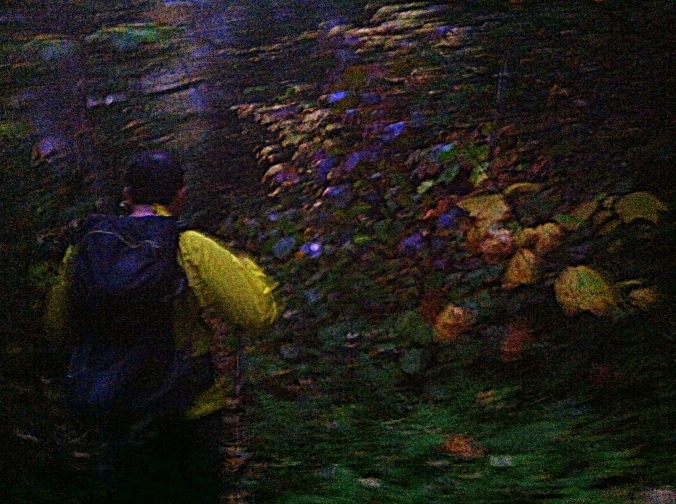
In the dark and on the move—Dave in the early AM.
I’d been alpine climbing this summer in the North Cascades and those approaches certainly help to put me line for a 50-miler, but I knew that nothing beats the real thing when it comes to training, and I’d have to do many a running mile to prep. In August, I swapped out my mountain boots for running togs while I was climbing over in Central Europe. And, though I’ve never had a natural compulsion to run, the sinewy streets and accretion of ages of architecture in Budapest, Vienna, Passau, Regensberg and the like provided visual eye-candy to tempt me to the taking.

Scenes from my summer of running—Europe’s architecture is wild—but it’s not wilderness.
Problem is, aside from the fact that those millenium-old architectural wonders are the antithesis of “America’s Crown Jewels” of wilderness, all those lovely little European cities also occur along the Danube River—which is to say that for all in intensive purposes the running is flat. That might explain why, somewhere toward the top of Mount Tripyramid, deep in the Sandwich Range Wilderness, my hamstring seemed to twanging like the high string of a banjo. Now, some might look at the relative 4160′ elevation of Tripyramid and wonder what the fuss is, but as any analyst of trails will tell you, eastern trails were built back in the day when, if a person wanted to get to the top of a mountain, they went to the top of the mountain. No switchbacks, no horseback graded paths, just up. So up we went. This was not the Danube.
One feature of American Wilderness (I’ll use capital “W” to connote the political definition) being “untrammeled by man (sic)” is that these areas tend to be more off the beaten path and the trails themselves deliver more of a beating—they’re rustic, rooted, rife with fallen trees to limbo under or hurdle over (chainsaws, being mechanized instruments, aren’t allowed in Wilderness). And though exceptions are certainly made for the trammeling by humans that things like trail signs present, their prevalence is certainly diminished in Wilderness Areas…
Which explains for why we may have actually run 52 miles. At a junction along the Livermore Trail, heading toward the Kancamangus Highway, the lay of the land seemed to suggest that we should head downhill—or maybe that was just the power of positive thinking once again gone awry. Enjoying a blissful run down evenly graded logging road, we began to wonder why we didn’t remember seeing a logging road on this section of the map we plotted…and then we turned around. The evenly graded logging road was not nearly as pleasant on the return.
Between the fog-navigational challenges and our most recent misstep, and with some cell reception showing, Dave called his partner Rachel—our pit crew at the 27-mile mark—to let her know we’d be a bit longer. Leaving the Sandwich Range Wilderness and entering the Pemigewasset Wilderness, our path onward went wonderfully well at first, with long stretches along the Sawyer River Trail’s wide, flat expanses, and then for slower and markedly unpleasant stretches of side-hilling and squeezing every last drop of water out of the spruces that clogged the Hancock Notch Trail.
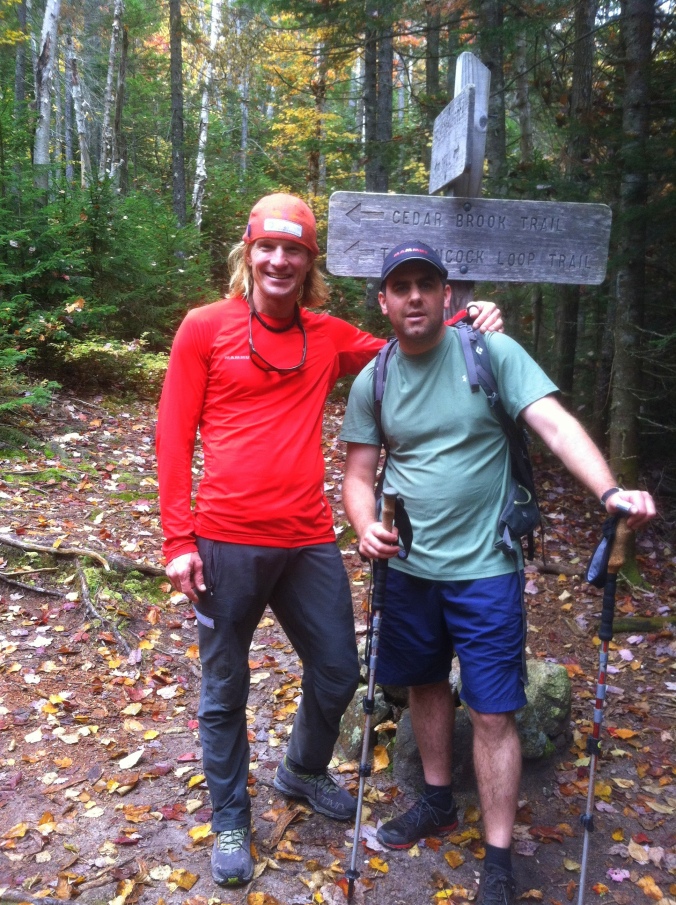
Twenty-seven miles in and looking good—or at least we’re smiling!
Coming into our pit stop was sweet relief—both because it meant we were more than halfway and because of the Christmas-cornucopia of treats it supplied. In that sort of third-person view on oneself that tiredness can provide, I saw myself sitting there on the curb of the parking lot along the Kancamangus Highway, with a half-eaten banana on my knee, shoveling fried rice into my mouth with my hand (I’d forgotten to pre-pack a spoon), taking swigs of my Very Green juice drink in between. I may have looked like a wreck, but I was a wreck refueling. After a few hundred more calories went in, I treated myself to a pair of dry Darn Tough’s, peeling off the mucky Light Hiker Micro Crew’s and feeling the cosiness of a fresh pair.
The rest of the run went by in flashes and blurs of the Northeast’s celebrated autumn paparazzi of color. In yet, for all it’s show of glory, we were it’s only witness. We never saw another soul along the trail. The wild trails of the Pemi interior gave way to the popular Ethan Pond Trail at its edges. Still no souls. Our plotting out of 50 precise miles had required some routing jiggery, and one outcome of that was that our last three miles of this wilderness run would be along the tracks of the scenic train running up to Crawford Notch. While on the one hand train tracks are hardly emblematic of wilderness, on the other, running along those quiet, straight, and graded final miles provided a time for transitioning back to civilization and for pondering what wilderness means to me, fifty years after it was politically defined, and some twenty years after I began exploring its various expanses on the American map.
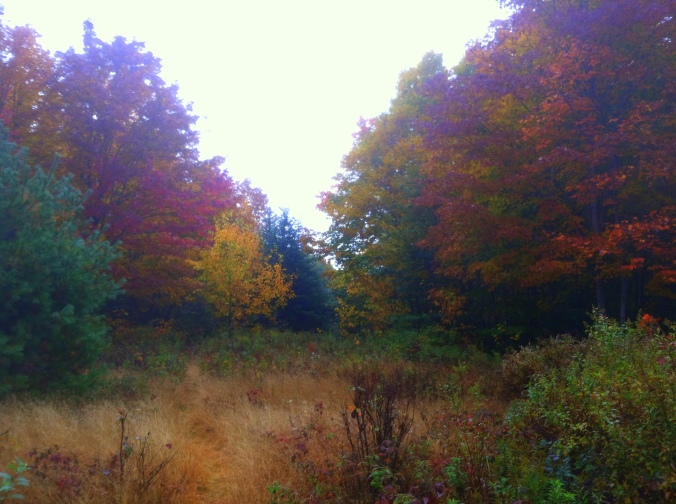
Entering the colorful flatlands of the Sawyer River Trail
During that exploration, I’ve seen many straightaway paths in my thinking, but switchbacks as well. In those twenty years of Wilderness exploration, I have transtioned from a outdoor neophyte to a person who makes his living and his life in natural places. I still believe in the symbolic and real gesture of wilderness as a place where humanity puts aside it’s claim to the top triangle of the pyramid, puts aside its desperate clinging to scientific rationalism, and says, in effect, “In this place, nature knows best.” In yet, I also realize the attraction that these places hold to those with wild spaces still left within their hearts, and I realize that unless that value is understood by the wider herd, then the resource will ultimately wither: In order to be valued, Wilderness must be encountered. And in order to be saved, Wilderness must be valued…but if too many are encountering it, is it still wilderness?
As I jogged along—OK, maybe now it was more of a fast-walk—thinking about such contradictions and conundrums in my own thought, I by necessity also reflected on some of the contradictions, conundrums, and just plain confounding actions of those we’ve appointed to manage these Wilderness places. They’ve got a tough job. Defining the reasonable boundaries of human activity in a place that is supposed to be wild makes you something of the adult chaperones at a high school homecoming dance. A recent flashpoint in my guiding community has been the issue of placing bolts on the rappel route off of the West Ridge of Forbidden Peak, a “Fifty Classics Climb” in the North Cascades. To put is quickly, this route is in a Wilderness Area and a guide put in bolted rappel anchors on a descent path that was previously riddled with an ugly confetti of rope, webbing, and whatever else. The National Park Service cut those bolts in an unusual display of efficiency and authority and then, not long after, a climber was killed by rockfall while negotiating these confetti anchors (see Rock & Ice’s article HERE for some background and analysis on this specific incident).

Scenes from this summer in the alpine—on the classic wilderness route, West Ridge of Forbidden Peak.
I strongly admire and support the idea that declaring an area as Wilderness is an admirable gesture of restraint among our all-too-ambitious race, but I also believe in consistency of thought and critical reflection in its execution. Speaking generally, one could argue that trails themselves—and maintained trails are prevalent in Wilderness Areas–are evidence of “trammeling”. More particularly with Forbidden Peak, one might wonder how nylon tat—with its goudy array of colors and a UV decay time of somewhere around the current age of the Wilderness Act—is somehow more “natural” and less “impact” than two simple 3/8” cylinders drilled 2” deep into a rock expanse the size of a vertical football field. Particularly when apart from the fauna that inhabit those alpine reaches—who are not in any way affected by the bolts (or the tat, for fairness I have to say)–the only people who might conceivably see those bolts are climbers. And if there are climbers who choose to eschew the bolts in favor of their own “wild” solution, let them express that wildness and leave their own tat mess.
These kinds of contentions and contradictions are evident throughout the history of Wilderness over the past 50 years. Many have struggled individually with the question of what “wilderness” really is and as a society we have struggled with the question of what the value of “Wilderness” is and also the question of who it is that really values—and benefits from—its existence.
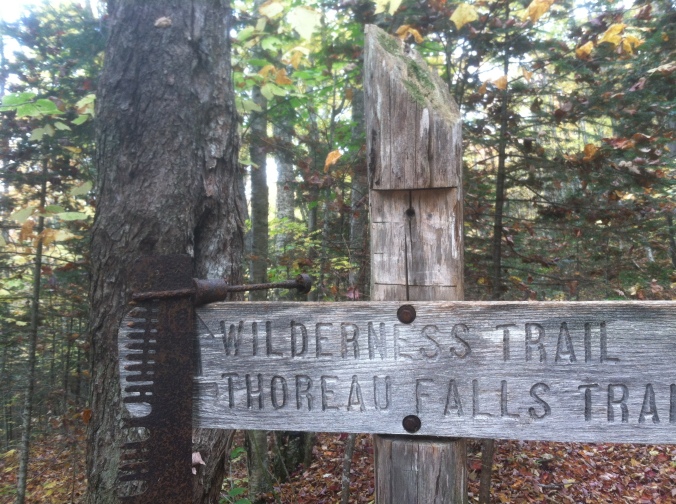
Fifteen miles go until we reach the edge of civilization.
The fact that I was thinking about Wilderness as it pertains to climbing while completing the last three miles of this “50 Miles of Wilderness for 50 Years of Wilderness” run is perhaps telling. In so far as I enjoyed the process of training for the run and the many hours of trail time contemplation it afforded, I am at the root a climber: No walk, hike, or run should begin without an ultimate climb in mind or end without some kind of climb having been accomplished. But whether trail runner at root or climber at the core, it is well worth considering and celebrating the 50th Anniversary of The Wilderness Act, embracing the concept of wilderness in its variety of interpretations, seeking out one’s own definition for it, and joining in that diversity of conversations, and—ultimately and most importantly feeling the sense of wildness in your own bones that wide open, wild spaces can offer.
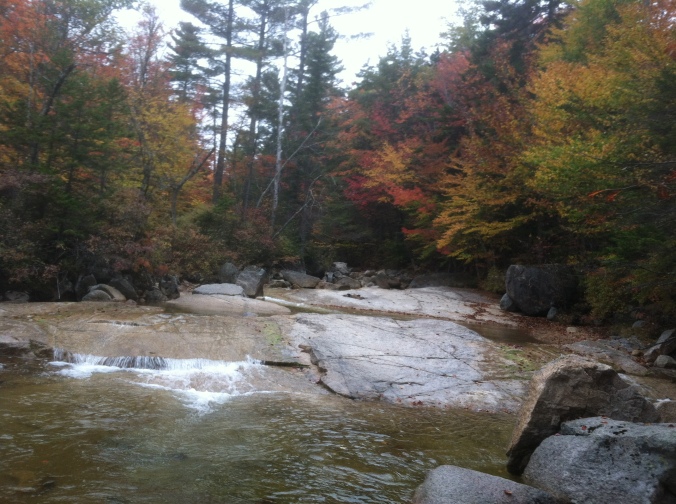
Untrammeled—and just perfect.















